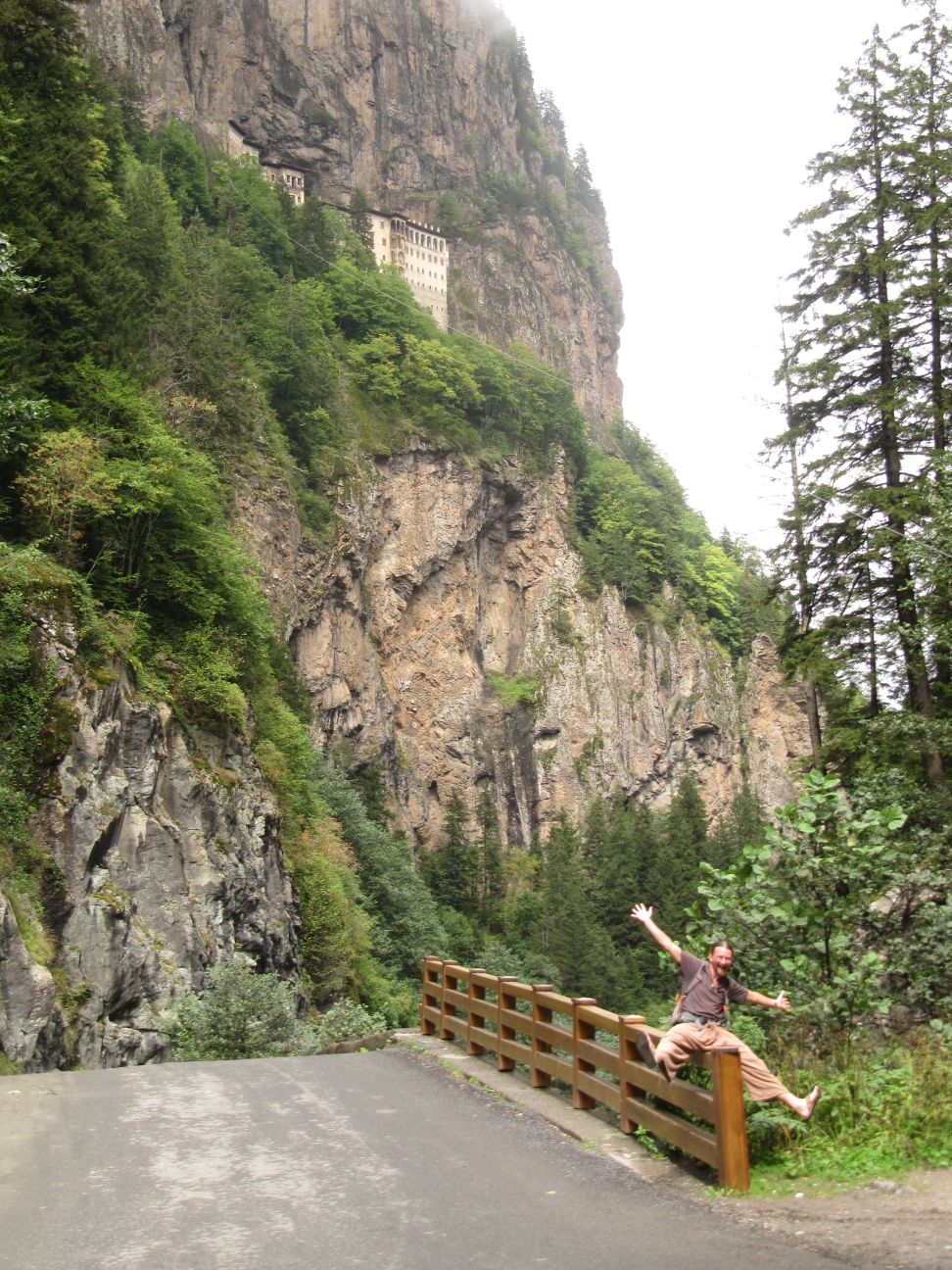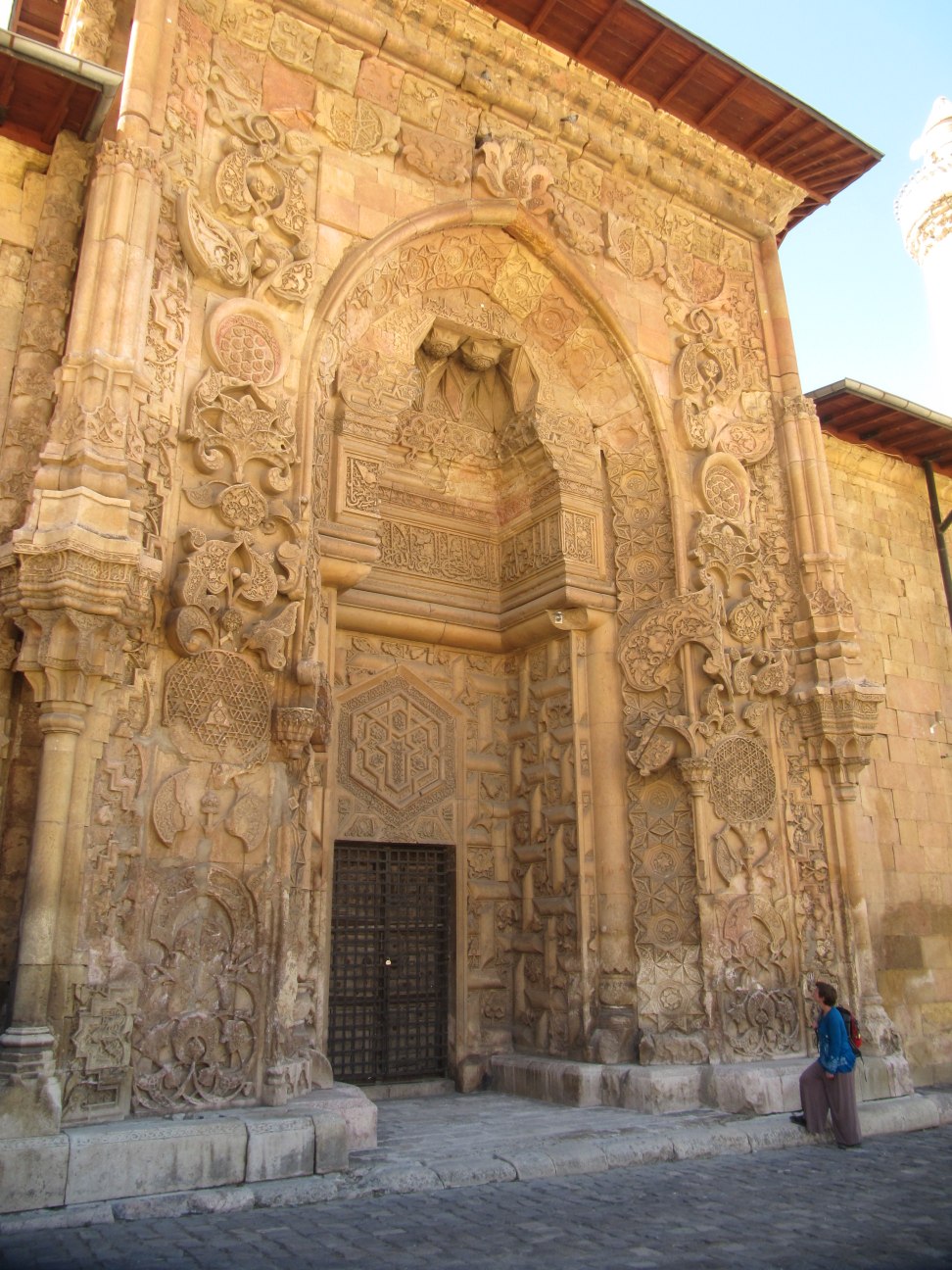With my bike in the boot of our small rental car, we venture out towards Trabzon. The new masterplan is to get the Iran visa there, then come back to Göreme and get on the Trans-Asia-Express from Turkey to Iran. We can buy the train tickets 10 days in advance in Kayseri.
Sivas, two hours North of Kayseri is a city full of history. Sivas is located at an important junction of the ancient Silk Road, and has a massive old Kervanseray with Hamam. Kervanserays were important protective shelters for traveling salesman in Medieval times. The Ulus Cami in Sivas dates back to the Seldjuks. This mosque was built without dome but a vast arch hall and its old brick stone minaret lots its balance in the last few centuries. Most attractive for us is the old Medrese, a medieval Quaran school. The square shaped building is made of big white stones. The corners of the building are round-shaped and decorated extensively with geometric ornaments and flowers. The likewise beautifully decorated main portal is framed by two brick stone minarets. The bricks are arranged to three-dimensional patterns on the top, and colored black and blue in addition. The courtyard is currently a construction side, and playground of some kids. One of them, Mohammed, leads us up to the roof on some wooden ladders, then he shows us the stairs to the minaret. Kathrin climbs ahead over the narrow and dove dung covered stairs in the dark. I try to picture the Muezzins days before loud speakers were installed everywhere. Five times a day up, singing as loud as you can and then down these stairs again. I'm pretty happy to get back to the ground.
On the following day we drive through narrow gorges and climb fantastic mountain roads. South of the pass, the landscape is rather dry. Naked rocky mountains glimmer in any variations of orange, red, white, yellow and dark brown. An ancient castle sits on top of a massive rock near Sebinkarahisar. Beside this town and a few farms, we see hardly traces of civilization. Near the top there is fog and rain and temperatures below 10 degrees. Beyond, we enter dense forests in rocky mountains. The vivid green makes not only our eyes happy. It lifts our sun-dried spirits too. Near the villages the jungle is replaced by large hazelnut grooves. From Giresun we take the motorway along the coast to Trabzon. The 4-lane road is excellently paved for high-speed. Beside traffic lights and pedestrian crossings, there is even sudden left-turns on the fast lane. One must be highly alert to drive here.


Trabzon has been the last bastion of the Byzantine empire in Asia, but fell in Ottoman hands shortly after Constantinople. We manage to find a cheap hotel off the tourist track, and spoil ourselves with a great fish meal. The visa mission basically worked out well. Beside the fuss of loosing and retrieving my credit card, queuing and waiting at the Iranian embassy and the bank there is not much time for sightseeing. Yet we meet a bunch of travelers from all over the world with the same destination, and end up smoking a water pipe with a Chinese who studies in Germany.
On the following day, we drive up some 50 km to the Sumela monastery. Around 300AD, a monk started up what should become a famous religious center during all the political fuss of the subsequent centuries. Even Muslim emperors visited and supported this place, 200 meters up in the middle of a giant cliff. Its mission ended only with the Greek-Turkish peoples exchange in the early 20th century. Today, it is a prominent tourist side, famous for the well-conserved frescoes at the cave church inside.
I hop on my bicycle, and Kathrin takes the car. The major mountain road from Trabzon to Gümüshane is, like many other roads, currently under construction. That is, a wide highway is milled into the rocks, and the remaining lane is occupied by heavy trucks carrying gravel and rocks. Not much fun to cycle. Luckily, there is a parallel old road on the other side of the valley, leading through lush forests and little villages with farms. The night we put our tent behind a gas station just outside Gümüshane.
From Gümüshane we take route 885 via Köse Gecidi and Ahmedyie Gecidi to Erzincan, two passes of about 2000m. Kathrin enjoys the car ride and lots of time for reading, I enjoy the cycling up- and downhill and mourn about the heavy west wind on the flat stretches between the passes. The next day we move on towards Divrigi in a beautiful green valley with a considerably big river. The mountain-backed valley narrows to fantastic gorges every now and then. The railroad leads through tunnels, the road goes over the mountains. Again, heavy west wind increases the training value for the cyclist. Later we learn this is the Euphrat, the cradle of human civilization, agriculture and domestication. Some 50 kilometers later we stop in Kemah. There are old Seljuk tombs and the ruins of a once mighty castle dating back to early Byzantine times. An old man with a distinct Swiss-German dialect invites us for tea. He normally runs a Kebap in Switzerland.
We leave the river and drive another mountainous 100 kilometers until Divrigi. I'm happy in the car, off the fierce west wind. Not more than a few farms, dry harvested wheat fields and goat flocks to see out here. We park the car in a lush valley a hundred meters off the road, and prepare our dinner by sunset. It would be great to spend the night out here and watch the stars. Kathrin disappears into the shrubs, just to call me an instant later... In the light beam of my head lamp I see here coming back, followed by two pairs of sparkling eyes. Apparently, she found some new “friends” – growling big Shepherd dogs. Luckily, their owners, two old man come just a few minutes later. They are very friendly but insist we should not stay here over night. The actual reason we don't understand with our sparse Turkish vocabulary. However, they are armed with big rifles. In that case, we might as well take a hotel in nearby Divrigi.
{youtube}outUlB3z9Sk{/youtube}
Few tourists are seen in charming Divrigi. The Seljuk mosque and hospital date back to the 13th century. While the mosque was founded by Shah Ahmed, the connected hospital was founded by his wife. The 4 tall stone portals of the building are greatly decorated with a mix of geometric ornaments, flowers and trees. Some parts focus especially on the equality of man and woman. The building is one of the most important medieval buildings in Anatolia, and became UNESCO heritage in 1985. In addition, some ancient tombs and the old town center with its narrow cobblestone streets and half faded wooden houses are definitely worth seeing.
Some more mountain ranges cycled with fierce headwind and a noisy night spent camping next to a Gendarme station in the highlands, we arrive back in Göreme. Ahmed and the cats on the camping are happy to see us again. A young German family with three kids, an Oldtimer Mercedes bus and a big dog stays on the campground. They are on their way to India. Surprisingly, two cycling couples from Scotland and France are just nearby, and visit us on the campground for gossip, coffee and beers.